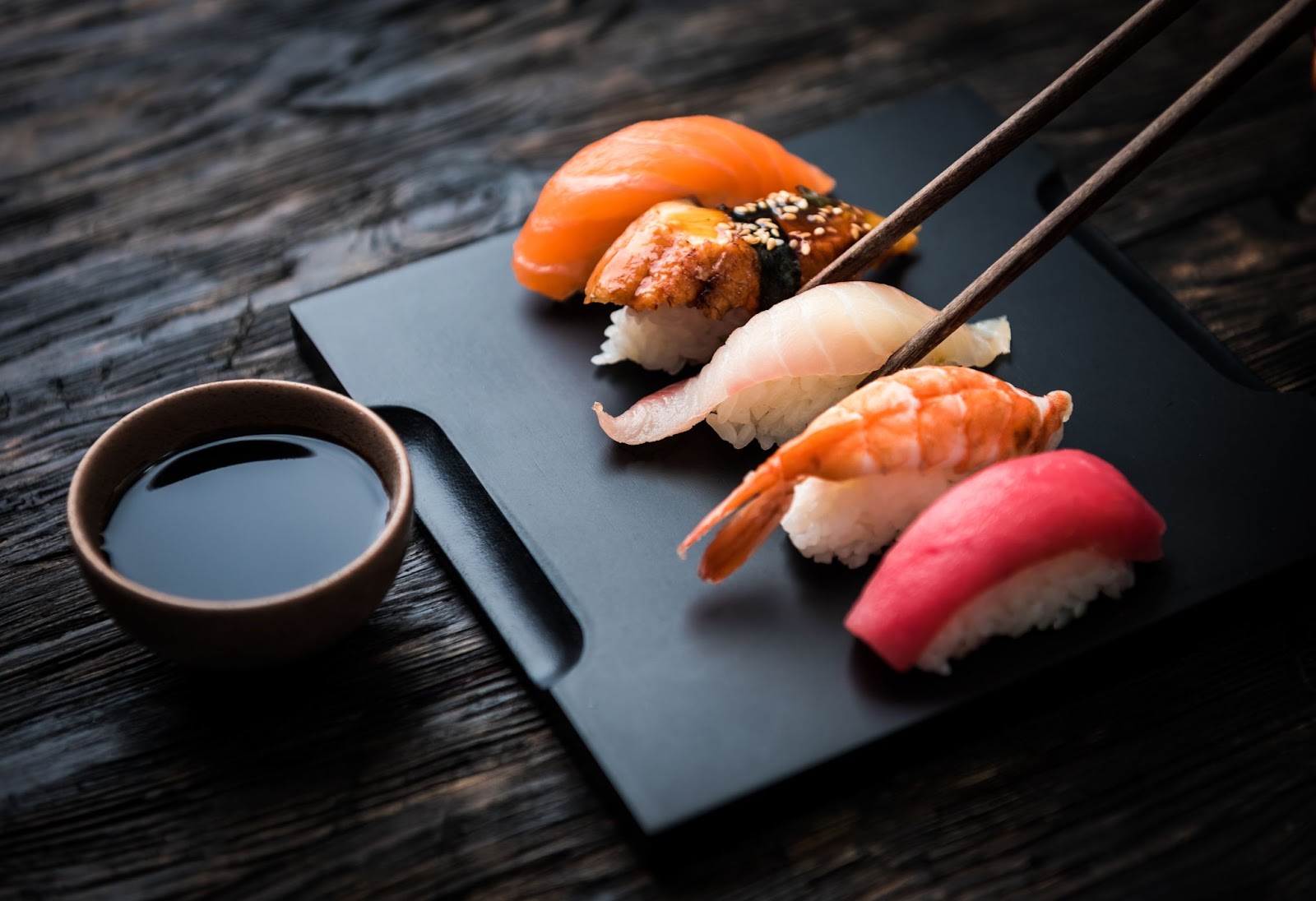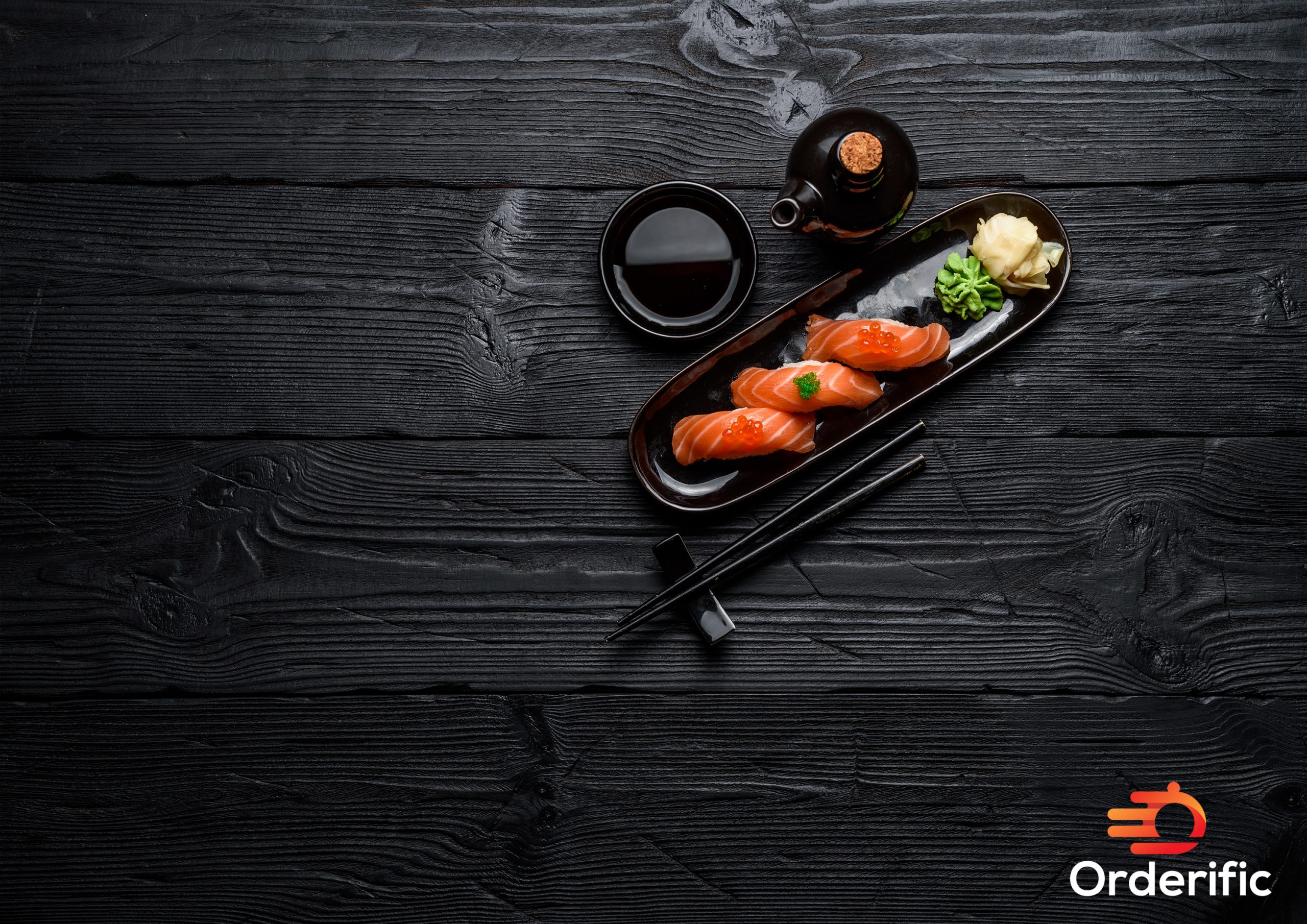Sushi goes beyond a simple meal; it’s an exquisite culinary adventure that captivates all your senses. With its roots tracing back centuries in Japan, nigiri and sushi has transformed into an adored cuisine enjoyed worldwide.
As you step foot into a sushi restaurant or peruse the menu of a Japanese eatery, prepare yourself for a delightful encounter with an array of sushi varieties. Nigiri and sashimi each offer a distinct and captivating gastronomic journey.
In this blog post, we will delve into the captivating secrets of sushi, nigiri, and sashimi. We will unravel the intricate details that distinguish them from one another.
Meaning of Sushi
Let’s begin our exploration by delving into the heart and soul of sushi. Sushi is a beloved traditional Japanese dish. It harmoniously brings together vinegared rice, referred to as “shari,” with a delightful medley of elements.
These components encompass an array of seafood, both raw and cooked. Along with it go the vibrant vegetables, exotic fruits, and even the addition of a delicate egg.
The key to crafting a truly tantalizing sushi lies in the quality of its components. The meticulous balance and artistry infused throughout its creation are also important.
The Most Popular Types of Sushi
Sushi has evolved over the centuries, leading to various culinary expressions and creative adaptations. Some of the most popular types of sushi include:
Nigiri Sushi:
Nigiri sushi is a true embodiment of Japanese culinary finesse. The term “nigiri” translates to “two fingers” in Japanese, referring to the two-finger-shaped mounds of vinegared rice that serve as the base. On top of these rice mounds, sushi chefs place slices of fresh, raw fish or seafood, often adding a touch of wasabi for extra flavor.
Maki Sushi:
Maki sushi, also known as sushi rolls, features seasoned rice and various ingredients rolled inside a sheet of nori (seaweed) and sliced into bite-sized pieces. The possibilities for fillings are endless, ranging from classic combinations like tuna and avocado to innovative fusions like spicy salmon and cream cheese.
Temaki Sushi:
Temaki sushi, also called hand rolls, allows diners to create their own sushi experience. It involves hand-rolling nori sheets around seasoned rice and an assortment of fillings to form a cone-shaped roll.
Uramaki Sushi:
Uramaki sushi, or inside-out rolls, flips the traditional sushi roll concept. In this type of sushi, the rice is on the outside, while the nori wraps around the fillings.
Chirashi Sushi:
Chirashi sushi translates to “scattered sushi” and presents a colorful bowl of vinegared rice topped with an assortment of fresh sashimi, vegetables, and other garnishes. This type of sushi is a visual delight, offering an array of colors and flavors in one bowl.
Inari Sushi:
Inari sushi showcases the sweet and savory fusion of seasoned rice filled inside aburaage, or fried tofu pouches. The pouches serve as edible containers for the sushi rice, making it a convenient and delightful sushi option.
What is Nigiri?
Among the various sushi types, nigiri stands out as an epitome of simplicity and sophistication. Nigiri sushi features small, hand-pressed mounds of vinegared rice, which are crafted with precise skill and attention to detail. The word “nigiri” translates to “two fingers,” referencing the shape of the rice mounds created by the sushi chef’s skilled hands.
Once the rice is formed, the chef delicately places a slice of fresh, raw fish or seafood on top of each rice mound. The fish selection is diverse and can include tuna, salmon, yellowtail, eel, and more. To elevate the flavors, a tiny dollop of wasabi is often placed between the rice and fish. The result is a delectable sushi masterpiece that showcases the natural flavors of the fish, with the seasoned rice acting as a complementary base.
What is Sashimi?
Sashimi and sushi often get mentioned together, but it’s important to know that sashimi is not a type of sushi. It stands on its own as a dish, highlighting the exquisite slices of raw fish or seafood. The name “sashimi” has a historical origin, coming from “sashi” (pierced or stuck) and “mi” (body or meat). Back in the day, fishmongers would identify fish species by piercing their tails, which inspired the name.
Unlike nigiri and other sushi varieties, sashimi is distinct in that it doesn’t incorporate vinegared rice or any other common sushi accompaniments. Sashimi is all about relishing the unadulterated flavors and textures of fish or seafood in their purest form.
What is the Difference Between Nigiri and Sashimi?
Nigiri and sashimi both highlight the exquisite flavors of fresh fish or seafood, but they stand apart in terms of presentation and ingredients. Nigiri, a delectable form of sushi, boasts delicate rice mounds crowned with the finest fish or seafood, accentuated by a touch of wasabi.
Conversely, sashimi indulges the palate with thinly sliced raw fish or seafood, served without accompaniments such as rice or other embellishments.
Nigiri, fundamentally, represents a distinct variety within the realm of sushi. On the other hand, sashimi offers a delightful dish that truly highlights the pure essence of fish or seafood, devoid of any accompaniments.
Conclusion
Sushi, with its incredible variety of flavors, textures, and stunning artistic presentations, never fails to amaze food enthusiasts across the globe. Delve into the nuances of sushi, nigiri, and sashimi to elevate your dining experience and truly embrace the artistry and skill behind every delectable creation.
Embark on a delightful gastronomic adventure as you explore the intricate flavors of nigiri and savor the pure essence of sashimi. Japanese cuisine beckons with a vibrant tapestry of culinary delights, where each sushi variety unveils its distinct allure. Immerse yourself in a remarkable dining experience that captivates both your senses and appreciation for cultural culinary mastery.
Now that you have gained a profound appreciation for sushi, nigiri, and sashimi, you are well-prepared to embark on an enchanting culinary journey. Each variation of sushi possesses its own unique allure, allowing Japanese cuisine to serve as a captivating exploration of diverse flavors, pleasing textures, and masterful artistry.
Whether you delight in the harmonious blend of nigiri or revel in the unadulterated simplicity of sashimi, the realm of Japanese gastronomy promises an array of options to satisfy discerning palates and dining preferences. Enjoy the gastronomic journey, and may each sushi experience be a delightful celebration of culture and culinary excellence.
In case you want more content like this, visit Orderific right now!
FAQs
Q: How to make Nigiri Sushi?
A: Start by preparing seasoned sushi rice using rice vinegar, sugar, and salt. After letting the rice cool down to room temperature, shape it into mounds with slightly damp fingers.
Q: How exactly do you prepare everything to make Nigiri Sushi?
A: Begin by cooking short-grain sushi rice and enhancing it with a blend of rice vinegar, sugar, and salt. Once the rice has cooled, shape it into small, oblong mounds.
Q: Why is sushi called nigiri?
A: The term “nigiri” in Japanese means “two fingers.” This name is derived from the fact that nigiri sushi is shaped into small mounds using two fingers of the sushi chef.
Q: What is the difference between tamago and nigiri sushi?
A: Tamago sushi has a delicate sweetness, while nigiri sushi emphasizes the natural flavors of the fish or seafood.
Q: How many calories are in nigiri sushi (with nori)?
A: Typically, a single portion of nigiri sushi, accompanied by nori, can provide approximately 50-70 calories.













